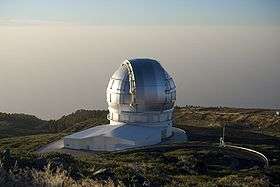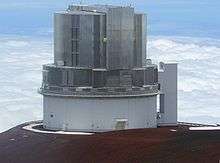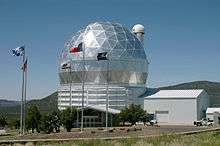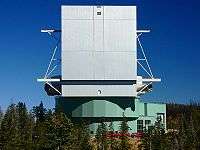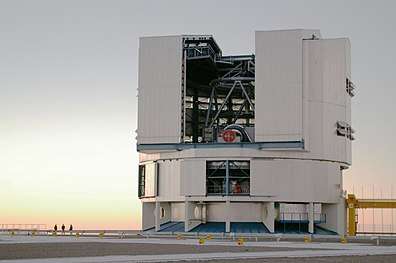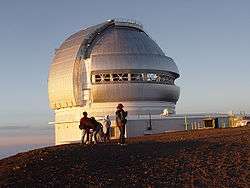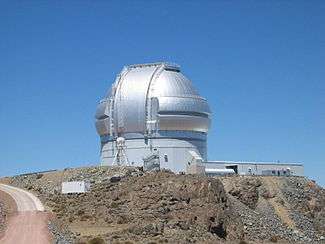List of largest optical reflecting telescopes
This list of the largest optical reflecting telescopes with objective diameters of 3.0 metres (120 in) or greater is sorted by aperture, which is a measure of the light-gathering power and resolution of a reflecting telescope. The mirrors themselves can be larger than the aperture, and some telescopes may use aperture synthesis through interferometry. Telescopes designed to be used as optical astronomical interferometers such as the Keck I and II used together as the Keck Interferometer (up to 85 m) can reach higher resolutions, although at a narrower range of observations. When the two mirrors are on one mount, the combined mirror spacing of the Large Binocular Telescope (22.8 m) allows fuller use of the aperture synthesis.
| |
| The world's largest optical reflecting telescopes with an aperture diameter of larger than 8 metres (hover with mouse over image).
Legend: |
Largest does not always equate to being the best telescopes, and overall light gathering power of the optical system can be a poor measure of a telescope's performance. Space-based telescopes, such as the Hubble Space Telescope, take advantage of being above the Earth's atmosphere to reach higher resolution and greater light gathering through longer exposure times. Location in the northern or southern hemisphere of the Earth can also limit what part of the sky can be observed, and climate conditions at the observatory site affect how often the telescope can be used each year.
Table of reflecting telescopes
This list is ordered by optical aperture, which has historically been a useful gauge of limiting resolution, optical area, physical size, and cost. Multiple mirror telescopes that are on the same mount and can form a single combined image are ranked by their equivalent aperture. Fixed altitude telescopes (e.g. HET) are also ranked by their equivalent aperture. All telescopes with an effective aperture of at least 3.00 metres (118 in) at visible or near-infrared wavelengths are included.
| Name | Image | Effective aperture | Mirror type | Nationality / Sponsors | Site | First light | |
|---|---|---|---|---|---|---|---|
| Large Binocular Telescope (LBT) | 11.9 m (469 in) (combined)[1] | Multiple Two 8.4 m (331 in) mirrors | USA, Italy, Germany | Mount Graham International Observatory, Arizona, USA | 2004 | ||
| Gran Telescopio Canarias (GTC) | 10.4 m (409 in) | Segmented 36 hexagonal segments | Spain (90%), Mexico, USA | Roque de los Muchachos Obs., Canary Islands, Spain | 2006 | ||
| Hobby-Eberly Telescope (HET) | 10 m (394 in) (effective) [2] | Segmented 91 × 1 m (39 in) hexagonal segments forming a 11 m × 9.8 m mirror | USA, Germany | McDonald Observatory, Texas, USA | 1997 Aperture increased 2015 | ||
| Keck 1 | 10 m (394 in) | Segmented 36 hexagonal segments | USA | Mauna Kea Observatories, Hawaii, USA | 1993 | ||
| Keck 2 | 10 m (394 in) | Segmented 36 hexagonal segments | USA | Mauna Kea Observatories, Hawaii, USA | 1996 | ||
| Southern African Large Telescope (SALT) | 9.2 m (362 in) (effective)[3] | Segmented 91 × 1 m (39 in) hexagonal segments forming a 11 m × 9.8 m mirror | South Africa, USA, UK, Germany, Poland, New Zealand | South African Astronomical Obs., Northern Cape, South Africa | 2005 | ||
| Subaru (JNLT) | 8.2 m (323 in) | Single | Japan | Mauna Kea Observatories, Hawaii, USA | 1999 | ||
| VLT UT1 – Antu | 8.2 m (323 in) | Single | ESO Countries, Chile | Paranal Observatory, Antofagasta Region, Chile | 1998 | ||
| VLT UT2 – Kueyen | 8.2 m (323 in) | Single | ESO Countries, Chile | Paranal Observatory, Antofagasta Region, Chile | 1999 | ||
| VLT UT3 – Melipal |  | 8.2 m (323 in) | Single | ESO Countries, Chile | Paranal Observatory, Antofagasta Region, Chile | 2000 | |
| VLT UT4 – Yepun | 8.2 m (323 in) | Single | ESO Countries, Chile | Paranal Observatory, Antofagasta Region, Chile | 2001 | ||
| Gemini North (Gillett) | 8.1 m (319 in) | Single | USA, UK, Canada, Chile, Australia, Argentina, Brazil | Mauna Kea Observatories, Hawaii, USA | 1999 | ||
| Gemini South | 8.1 m (319 in) | Single | USA, UK, Canada, Chile, Australia, Argentina, Brazil | Cerro Pachón (CTIO), Coquimbo Region, Chile | 2001 | ||
| MMT (current optics) |  | 6.5 m (256 in) | Single | USA | F. L. Whipple Obs., Arizona, USA | 2000 | |
| Magellan 1 (Walter Baade)[4] | 6.5 m (256 in) | Single | USA | Las Campanas Obs., Atacama Region, Chile | 2000 | ||
| Magellan 2 (Landon Clay) | 6.5 m (256 in) | Single | USA | Las Campanas Obs., Atacama Region, Chile | 2002 | ||
| BTA-6 | 6 m (236 in) | Single | USSR/Russia | Special Astrophysical Obs., Karachay–Cherkessia, Russia | 1975 | ||
| Large Zenith Telescope (LZT) | 6 m (236 in) | Liquid | Canada, France, United States [5] | Maple Ridge, British Columbia, Canada | 2003 Decommissioned 2019 | ||
| Hale Telescope | 5.08 m (200 in) | Single | USA | Palomar Observatory, California, USA | 1948 | ||
| LAMOST | 4.9 m (193 in) (effective)[6] | Segmented 37 segments for the 6.67 m × 6.05 m primary and 24 segments for the 5.72 m × 4.40 m corrector; effective aperture 3.6–4.9 m[7] | China | Beijing Astronomical Obs., Xinglong, China | 2008 | ||
| MMT (original optics) (see above for current version) |  | 4.7 m (185 in) (combined)[8] | Multiple Six 1.8 m (71 in) mirrors | USA | F. L. Whipple Obs., Arizona, USA | 1979 Mirrors removed 1998 | |
| Lowell Discovery Telescope[9] | 4.3 m (169 in) | Single | USA | Lowell Observatory, Happy Jack, Arizona, USA | 2012 | ||
| William Herschel Telescope | 4.2 m (165 in) | Single | UK, Netherlands, Spain | Roque de los Muchachos Obs., Canary Islands, Spain | 1987 | ||
| SOAR | 4.1 m (161 in) | Single | USA, Brazil | Cerro Pachón (CTIO), Coquimbo Region, Chile | 2002 | ||
| VISTA | 4.1 m (161 in) | Single | ESO Countries, Chile | Paranal Observatory, Antofagasta Region, Chile | 2009 | ||
| Victor M. Blanco Telescope | 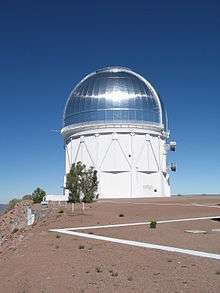 | 4 m (157 in) | Single | USA | Cerro Tololo Inter-American Obs., Coquimbo Region, Chile | 1976 | |
| Nicholas U. Mayall 4 m[10] | 4 m (157 in) | Single | USA | Kitt Peak National Obs., Arizona, USA | 1973 | ||
| Daniel K. Inouye Solar Telescope | 4 m (157 in) | Single | USA | Haleakala Observatory, Hawaii, USA | 2019. | ||
| Anglo-Australian Telescope (AAT) | 3.89 m (153 in) | Single | Australia, UK | Australian Astronomical Obs., New South Wales, Australia | 1974 | ||
| United Kingdom Infrared Telescope (UKIRT) | 3.8 m (150 in) | Single | UK, United States | Mauna Kea Observatories, Hawaii, USA | 1979 | ||
| 3.67 m AEOS Telescope (AEOS) |  | 3.67 m (144 in) | Single | USA | Air Force Maui Optical Station, Hawaii, USA | 1996 | |
| 3.6 m Devasthal Optical Telescope[11] (DOT) | 3.6 m (142 in) | Single | India | ARIES Devasthal Observatory, Nainital, India | 2016 | ||
| Telescopio Nazionale Galileo (TNG) | 3.58 m (141 in) | Single | Italy | Roque de los Muchachos Obs., Canary Islands, Spain | 1997 | ||
| New Technology Telescope (NTT) | 3.58 m (141 in) | Single | ESO countries | La Silla Observatory, Coquimbo Region, Chile | 1989 | ||
| Canada-France-Hawaii Telescope (CFHT) | 3.58 m (141 in) | Single | Canada, France, USA | Mauna Kea Observatories, Hawaii, USA | 1979 | ||
| ESO 3.6 m Telescope | 3.57 m (141 in) | Single | ESO countries | La Silla Observatory, Coquimbo Region, Chile | 1977 | ||
| MPI-CAHA 3.5 m[12] | 3.5 m (138 in) | Single | West Germany, Spain | Calar Alto Obs., Almería, Spain | 1984 | ||
| USAF Starfire 3.5 m [13] |  | 3.5 m (138 in) | Single | USA | Starfire Optical Range, New Mexico, USA | 1994 | |
| WIYN Telescope | 3.5 m (138 in) | Single | USA | Kitt Peak National Obs., Arizona, USA | 1994 | ||
| Space Surveillance Telescope | 3.5 m (138 in) | Single | USA | White Sands Missile Range, New Mexico, USA | 2011 | ||
| Astrophysical Research Consortium (ARC) | 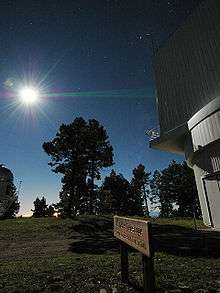 | 3.48 m (137 in) | Single | USA | Apache Point Obs., New Mexico, USA | 1994 | |
| Shane Telescope | 3.05 m (120 in) | Single | USA | Lick Observatory, California, USA | 1959 | ||
| NASA Infrared Telescope Facility | 3.0 m (118 in) | Single | USA | Mauna Kea Observatory, Hawaii, USA | 1979 | ||
| NASA-LMT | 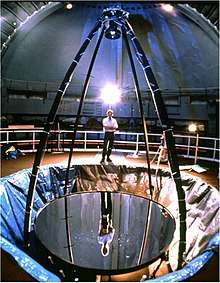 | 3 m (118 in) | Liquid | USA | NASA Orbital Debris Obs., New Mexico, USA | 1995 Decommissioned 2002[14] | |
| For continuation of this list, see List of large optical reflecting telescopes | |||||||
There are only a few sites capable of polishing the mirrors for these telescopes. SAGEM in France polished the four VLT mirrors, the two Gemini mirrors, and the 36 segments for GTC.[15] The Steward Observatory Mirror Lab cast and polished the two LBT mirrors, the two Magellan mirrors, the MMT replacement mirror, and the LSST primary/tertiary mirror. It is currently making the mirrors for the Giant Magellan Telescope.[16] The Keck segments were made by Schott AG. The SALT and LAMOST segments were cast and polished by LZOS.[17] The mirror for Subaru was cast by Corning and polished at Contraves Brashear Systems in Pennsylvania.[18]
This table does not include all the largest mirrors manufactured. The Steward Observatory Mirror Lab produced the 6.5-metre f/1.25 collimator used in the Large Optical Test and Integration Site of Lockheed Martin, used for vacuum optical testing of other telescopes.
Segmented mirrors are also referred to as mosaic mirrors. Single mirrors are also referred to monolithic mirrors, and can be sub-categorized in types, such as solid or honeycomb.
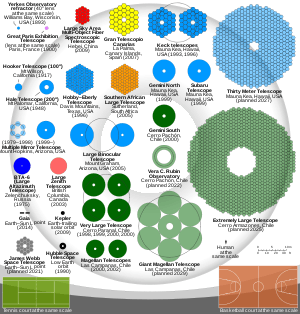
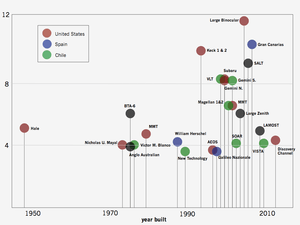
Chronological list of largest telescopes
These telescopes were the largest in the world at the time of their construction, by the same aperture criterion as above.
| Years Largest | Name | Out | In | Aperture (m) | Area (m2) | M1 Mirror | Note | Altitude (m) |
|---|---|---|---|---|---|---|---|---|
| 2009–Present | Gran Telescopio Canarias |  | 10.4 | 74 | 36 × 1.9 m hexagons M1 mirror | Segmented mirror | 2267 | |
| 1993–2009 | Keck 1 | 10 | 76 [19] | 36 × 1.8 m hexagons M1 mirror | Segmented mirror, M1 f/1.75 | 4145 | ||
| 1976–1993 | BTA-6 | 6 | 26 | 605 cm f/4 M1 mirror | Mirror replaced twice | 2070 | ||
| 1948–1976 | Hale (200 inch) | 5.1 | – | 508 cm f/3.3 M1 mirror | Art deco dome | 1713 | ||
| 1917–1948 | Hooker (100 inch) | 2.54 | – | Also used for 1st optical interferometer | 1742 | |||
| For earlier entries, see List of largest optical telescopes historically | ||||||||
Future telescopes

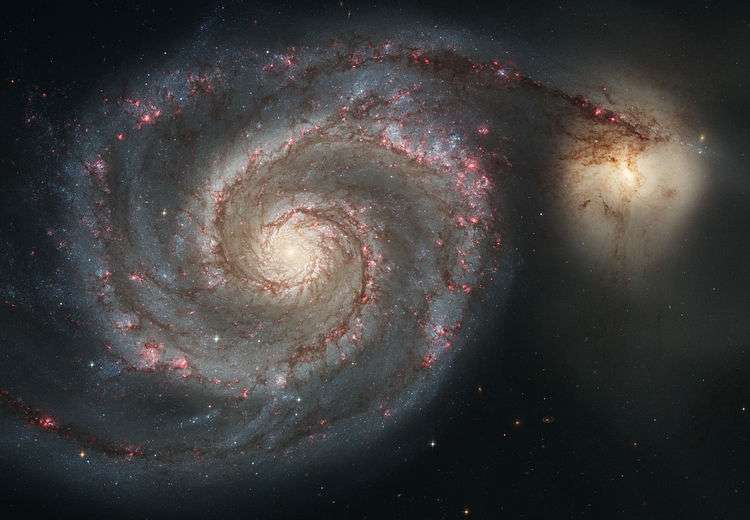
Under construction
These telescopes are currently under construction and will meet the list inclusion criteria once completed:
- European Extremely Large Telescope 39.3 m (1,550 in). First light planned in 2024.[20]
- Thirty Meter Telescope 30 m (1,200 in). First light planned in 2027.[21]
- Giant Magellan Telescope. Seven 8.4 m mirrors on a single mount, giving the resolving power of a single 24.5 m mirror and the light gathering area of a single 21.4 m mirror. First light planned in 2021 and completion in 2025.[22][23]
- Vera C. Rubin Observatory 8.4 m (330 in). First light planned in 2020 and full operations beginning in 2022.
- James Webb Space Telescope 6.5 m (260 in). Space telescope, launch planned in March 2021.[24]
- San Pedro Martir Telescope 6.5 m (260 in). First light planned in 2023.[25]
- Magdalena Ridge Observatory Telescope Array. Optical interferometer array, 10 telescopes each of 1.4 m (55 in) aperture; equivalent to a 4.4 m (170 in) single aperture.
- International Liquid Mirror Telescope 4 m (160 in). Construction began in 2013.[26]
- Timau National Observatory 3.8 m (150 in). First light planned in 2020 or 2021.[27]
- Iranian National Observatory 3.4 m (130 in). First light planned in 2020.[28]
Proposed
Selected large telescopes which are in detailed design or pre-construction phases:
- Large UV Optical Infrared Surveyor (LUVOIR), a proposed space telescope for launch in the mid 2030s.
- Tokyo Atacama Observatory (TAO) 6.5 m (260 in)[29]
- Chinese Giant Solar Telescope (CGST), an infrared and optical solar telescope, with light-gathering power equivalent to a 5 m diameter aperture [30][31]
See also
References
- SPIE 2006 in Orlando - Proceedings of SPIE conference 6267 on “Ground-based and Airborne Telescopes”, "The Large Binocular Telescope", John M. Hill, Richard F. Green and James H. Slagle
- "Upgraded Hobby-Eberly Telescope Sees First Light". McDonald Observatory. Retrieved 2016-07-29.
- "Howstuffworks "10 Amazing Telescopes"". Science.howstuffworks.com. Archived from the original on December 22, 2008. Retrieved August 19, 2009.
- "The Carnegie Observatories – Magellan Telescopes". Carnegie Institution for Science. Retrieved 2017-05-24.
- The Telescope, By Geoff Andersen, Page 165
- Archived July 22, 2011, at the Wayback Machine
- "LAMOST Homepage – Gallery". Lamost.org. August 13, 2012. Retrieved January 6, 2018.
- Dwayne DayMonday, May 11, 2009 (2009-05-11). "Mirrors in the dark". The Space Review. Retrieved 2012-01-03.CS1 maint: multiple names: authors list (link)
- Lowell Observatory - 4.3-meter DCT
- "The Mayall 4-Meter Telescope". Noao.edu. February 27, 1973. Retrieved August 19, 2009.
- Sagar, Ram; Brijesh Kumar; Amitesh Omar; A. K. Pandey (2012). "New optical telescope projects at Devasthal Observatory". Proceedings of the Society of Photo-Optical Instrumentation Engineers. Ground-based and Airborne Telescopes IV. 8444: 84441T. arXiv:1304.2474. Bibcode:2012SPIE.8444E..1TS. doi:10.1117/12.925634.
- "Max-Planck-Institut für Astronomie". Mpia.de. July 20, 1994. Retrieved August 19, 2009.
- John Pike. "Starfire". Globalsecurity.org. Retrieved August 19, 2009.
- "NASA Orbital Debris Observatory". Astro.ubc.ca. Retrieved August 19, 2009.
- "Polissage Optique pour les Grands Instruments de la Physique et de l 'Astronomie" (PDF). Archived from the original (PDF) on 2012-04-26.
- "Mirror Castings". Steward Observatory Mirror Lab.
- "Large Optics Manufacturing in Large Optics Manufacturing in Lytkarino Optical Glass Factory, Russia" (PDF). Archived from the original (PDF) on 2012-04-26.
- "SUBARU Telescope 8.3m Primary Mirror Finished".
- "Keck Telescope Facts". Spacecraftkits.com. Retrieved 2012-01-03.
- "Groundbreaking for the E-ELT (eso1419 — Organisation Release)". ESO. 19 June 2014. Retrieved 3 January 2015.
- TMT Timeline, accessed June 22, 2019
- "GMT – Overview". Gmto.org. Retrieved 2017-05-24.
- Amos, Jonathan (12 November 2015). "Giant Magellan Telescope: Super-scope project breaks ground". BBC News. Retrieved 2015-11-15.
- "NASA Completes Webb Telescope Review, Commits to Launch in Early 2021". NASA. 27 June 2018. Retrieved 3 July 2018.
- Universities in U.S. and Mexico Partner on Telescope Project. Arizona Public Media, 13 November 2017.
- "International Liquid Mirror Telescope – Extragalactic Astrophysics and Space Observations". Aeos.ulg.ac.be. Retrieved August 19, 2009.
- Irawan, Gita (2019-11-26). "Menristek Sebut Observatorium Nasional Timau NTT Ditargetkan Selesai Tahun Depan". tribunnews (in Indonesian). Retrieved 2020-05-19.
- Rezaei, Maryam (November 12, 2018). "پا گرفتن طرحی که در شرایط تحریم نباید پا میگرفت/قد کشیدن رصدخانه ملی از صفر تا ارتفاع ۳۶۰۰متری". ISNA. ISNA. Retrieved 12 November 2018.
- Yoshii, Y.; Doi, M.; Kohno, K.; Miyata, T.; Motohara, K.; Kawara, K.; Tanaka, M.; Minezaki, T.; Sako, S.; Morokuma, T.; Tamura, Y.; Tanabe, T.; Takahashi, H.; Konishi, M.; Kamizuka, T.; Kato, N.; Aoki, T.; Soyano, T.; Tarusawa, K.; Handa, T.; Koshida, S.; Bronfman, L.; Ruiz, M. T.; Hamuy, M.; Garay, G. (2016). "The University of Tokyo Atacama Observatory 6.5m telescope: Project overview and current status". Ground-Based and Airborne Telescopes Vi. 9906: 99060R. Bibcode:2016SPIE.9906E..0RY. doi:10.1117/12.2231391. hdl:10150/632264.
- "Introduction to the Chinese Giant Solar Telescope" (PDF).
- Staff (29 August 2012). "China Exclusive: Scientists looking for site for giant solar telescope". Retrieved 8 December 2014.
Further reading
- "The Astronomical Scrapbook", Joseph Ashbrook, Sky Publishing Corporation 1984, ISBN 0-933346-24-7, o
- "Giant Telescopes of the World", Sky and Telescope, August 2000.
- "The History of the Telescope", Henry C. King. (1955)
- "The Historical Growth of Telescope Aperture", René Racine, Publications of the Astronomical Society of the Pacific, 116
- JRASC (1929) vol 23, p351
- Sky&Telescope (April 1981) p303
- Sky&Telescope (July 1993) vol 86, p 27-32
- James H. Burge, 1993 Dissertation at UA, "Advanced Techniques for Measuring Primary Mirrors for Astronomical Telescopes"
- Bell, R.M. and Robins, G.C. and Eugeni, C. and Cuzner, G. and Hutchison, S.B. and Baily, S.H. and Ceurden, B. and Hagen, J. and Kenagy, K. and Martin, H.M. and Tuell, M. and Ward, M. and West, S.C. (July 2008). "LOTIS at completion of Collimator integration". Society of Photo-Optical Instrumentation Engineers (SPIE) Conference Series. 7017. Bibcode:2008SPIE.7017E..0DB. doi:10.1117/12.791889.CS1 maint: multiple names: authors list (link)
